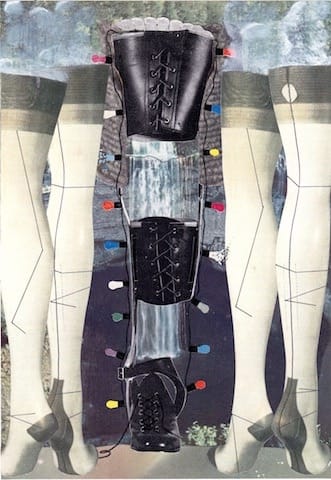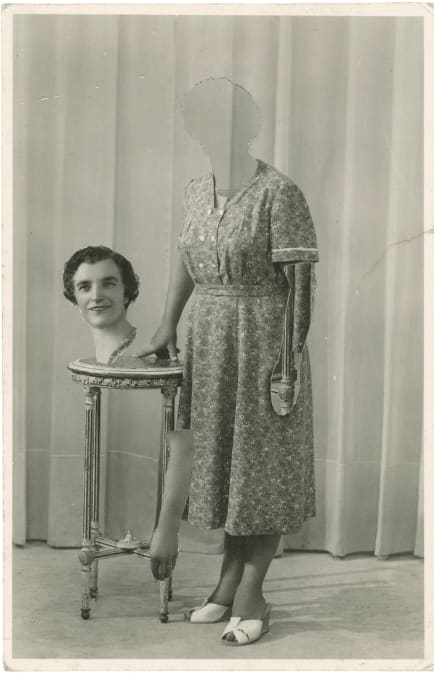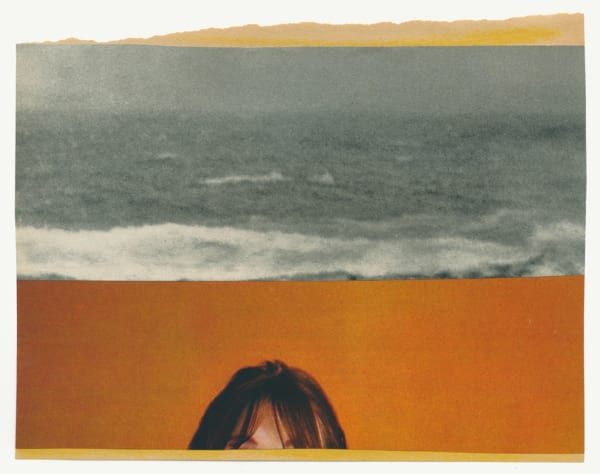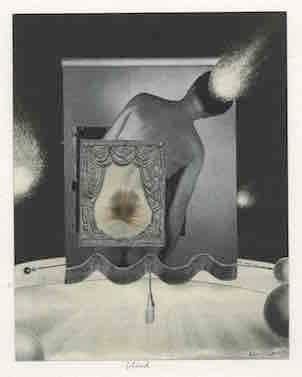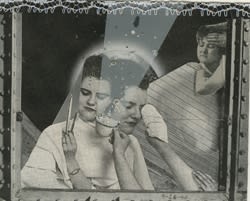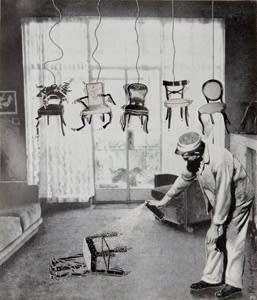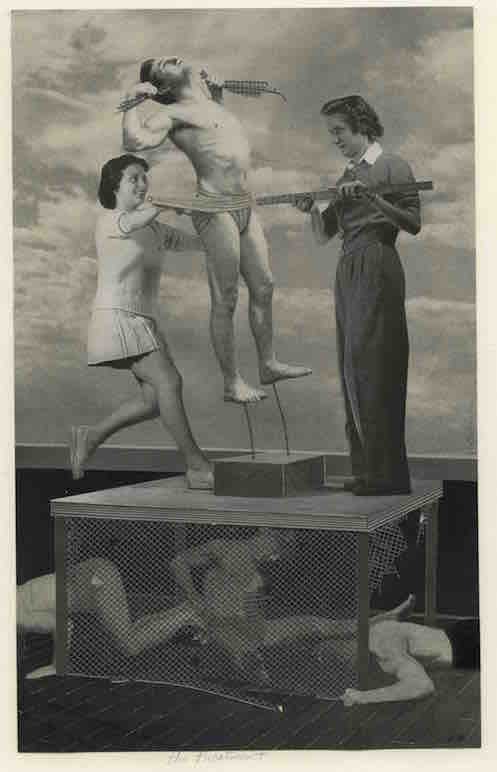Fragmented Lucidity
ROSEGALLERY
Katrien De Blauwer, Ken Graves, Kensuke Koike
9 December 2023 - 13 January 2024
Katrien De Blauwer, Ken Graves, Kensuke Koike
9 December 2023 - 13 January 2024
For inquiries, please contact Rose | rose@rosegallery.net.
-
 Ken GravesThe Home Movies, 1986Signed on print in pencilUnique mixed media collage7 x 7.75 inches
Ken GravesThe Home Movies, 1986Signed on print in pencilUnique mixed media collage7 x 7.75 inches -
 Ken GravesNest, 2015Signed on print in pencilUnique mixed media collage9.6 x 7 inch
Ken GravesNest, 2015Signed on print in pencilUnique mixed media collage9.6 x 7 inch
24.38 x 17.78 cm -
 Ken GravesSquash, 2011Signed on print in pencilUnique mixed media collage7.5 x 11 inches
Ken GravesSquash, 2011Signed on print in pencilUnique mixed media collage7.5 x 11 inches -
 Ken GravesOrthopedists, 2014Signed on print in pencilUnique mixed media collage7.5 x 6 inches
Ken GravesOrthopedists, 2014Signed on print in pencilUnique mixed media collage7.5 x 6 inches -
 Ken GravesArm Arrest, 2010Signed on print in pencilUnique mixed media collage5 x 7.5 inch
Ken GravesArm Arrest, 2010Signed on print in pencilUnique mixed media collage5 x 7.5 inch
12.7 x 19.05 cm -
 Ken GravesArtificial Leg, 2002Signed on print in pencilUnique mixed media collage5 x 8 inches
Ken GravesArtificial Leg, 2002Signed on print in pencilUnique mixed media collage5 x 8 inches -
 Ken GravesCharms, 2007Signed on print in pencilUnique mixed media collage7.31 x 8.13 inch
Ken GravesCharms, 2007Signed on print in pencilUnique mixed media collage7.31 x 8.13 inch
18.57 x 20.65 cm -
 Ken GravesShe was living an ordinary life, 1984Signed on print in pencilUnique mixed media collage3.5 x 6 inches
Ken GravesShe was living an ordinary life, 1984Signed on print in pencilUnique mixed media collage3.5 x 6 inches -
 Ken GravesBath Time, 1984Signed on print in pencilUnique mixed media collage3.75 x 8 inch
Ken GravesBath Time, 1984Signed on print in pencilUnique mixed media collage3.75 x 8 inch
9.53 x 20.32 cm -
 Ken GravesLeft to Right, Right to Left, 1998Signed on print in pencilUnique mixed media collage4.25 x 4 inches
Ken GravesLeft to Right, Right to Left, 1998Signed on print in pencilUnique mixed media collage4.25 x 4 inches -
 Kensuke KoikeLittle By Little, 2023Switched Vintage Photo4 x 6 inches
Kensuke KoikeLittle By Little, 2023Switched Vintage Photo4 x 6 inches -
 Kensuke KoikeMen Love Curves, 20135 1/4 x 2 3/8 inches
Kensuke KoikeMen Love Curves, 20135 1/4 x 2 3/8 inches -
 Kensuke KoikeThat Daddy, 20195.25 x 3.25
Kensuke KoikeThat Daddy, 20195.25 x 3.25 -
 Kensuke KoikeTraveller, 2020Switched Vintage Photo14 x 8.9 cm
Kensuke KoikeTraveller, 2020Switched Vintage Photo14 x 8.9 cm -
 Kensuke KoikeAmbassador, 2018Switched Vintage Photo6 x 3.75 inches
Kensuke KoikeAmbassador, 2018Switched Vintage Photo6 x 3.75 inches -
 Kensuke KoikeNaturist Master, 2022Switched Vintage Photo5 3/8 x 3 1/2 inches
Kensuke KoikeNaturist Master, 2022Switched Vintage Photo5 3/8 x 3 1/2 inches -
 Kensuke KoikeMirror of Truth, 2016Switched Vintage Photo5 x 3.25
Kensuke KoikeMirror of Truth, 2016Switched Vintage Photo5 x 3.25 -
 Kensuke KoikeNientte, 2017Switched Vintage Photo4 3/8 x 2 5/8 inches
Kensuke KoikeNientte, 2017Switched Vintage Photo4 3/8 x 2 5/8 inches -
 Kensuke KoikeThe Parent Trap, 2013Switched Vintage Photo5.5 x 3.5 inches
Kensuke KoikeThe Parent Trap, 2013Switched Vintage Photo5.5 x 3.5 inches -
 Kensuke KoikeOffice Romance, 2013Switched vintage photo14.9 x 10.5 cm
Kensuke KoikeOffice Romance, 2013Switched vintage photo14.9 x 10.5 cm -
 Kensuke KoikeSay Cheese, 2020Switched Vintage Postcard5 5/16 x 3 1/2 inches
Kensuke KoikeSay Cheese, 2020Switched Vintage Postcard5 5/16 x 3 1/2 inches -
 Katrien De BlauwerDirty Scenes 19, 2019Collage3.9 x 5.1
Katrien De BlauwerDirty Scenes 19, 2019Collage3.9 x 5.1 -
 Katrien De BlauwerColored Scenes 12, 2018Collage2.75 x 5.25 inches
Katrien De BlauwerColored Scenes 12, 2018Collage2.75 x 5.25 inches -
 Katrien De BlauwerCommencer 82, 2020Collage4.7 x 7.8
Katrien De BlauwerCommencer 82, 2020Collage4.7 x 7.8 -
 Katrien De BlauwerPainted Scenes 87, 2019Collage4.3 x 5.7 inches
Katrien De BlauwerPainted Scenes 87, 2019Collage4.3 x 5.7 inches -
 Katrien De BlauwerCommencer 115, 2020Collage6.75 x 4..5 inches
Katrien De BlauwerCommencer 115, 2020Collage6.75 x 4..5 inches -
 Katrien De BlauwerBlue Scenes 48, 2018Collage10 x 13 cm
Katrien De BlauwerBlue Scenes 48, 2018Collage10 x 13 cm
3.9 x 5.1 Inches -
 Katrien De BlauwerRed Scenes 27, 2018Collage4.1 x 5 inches
Katrien De BlauwerRed Scenes 27, 2018Collage4.1 x 5 inches -
 Katrien De BlauwerFaces 5 , 2022Collage5.5 x 7.75
Katrien De BlauwerFaces 5 , 2022Collage5.5 x 7.75 -
 Katrien De BlauwerRed Scenes 28, 2019Collage3.9 x 4.7 inches
Katrien De BlauwerRed Scenes 28, 2019Collage3.9 x 4.7 inches -
 Katrien De BlauwerColored Scenes 14, 2018Collage4.25 x 5.75 inches
Katrien De BlauwerColored Scenes 14, 2018Collage4.25 x 5.75 inches -
 Katrien De BlauwerFaces 4, 2022Collage7.75 x 6 inches
Katrien De BlauwerFaces 4, 2022Collage7.75 x 6 inches -
 Katrien De BlauwerPainted Scenes 86, 2019Collage10 x 14 cm
Katrien De BlauwerPainted Scenes 86, 2019Collage10 x 14 cm
2.9 x 5.5 inches -
 Katrien De BlauwerFaces 9, 2020Collage4.7 x 6 inches
Katrien De BlauwerFaces 9, 2020Collage4.7 x 6 inches -
 Ken GravesDream Team, 1989Signed on print in pencilUnique mixed media collage7.5 x 5.2 inches
Ken GravesDream Team, 1989Signed on print in pencilUnique mixed media collage7.5 x 5.2 inches -
 Ken GravesHeat Source, 2003Signed on print in pencilUnique mixed media collage5.75 x 4.25 inches
Ken GravesHeat Source, 2003Signed on print in pencilUnique mixed media collage5.75 x 4.25 inches -
 Ken GravesThe Meaning of Gravity, 2010Signed on print in pencilUnique mixed media collage6.5 x 4.78 inch
Ken GravesThe Meaning of Gravity, 2010Signed on print in pencilUnique mixed media collage6.5 x 4.78 inch
16.51 x 12.14 cm -
 Ken GravesSingle Parent, 1993Signed on print in pencilUnique mixed media collage4 x 3 inch
Ken GravesSingle Parent, 1993Signed on print in pencilUnique mixed media collage4 x 3 inch
10.16 x 7.62 cm -
 Ken GravesBlind, 2005Signed on print in pencilUnique mixed media collage4.6 x 3.75 inch
Ken GravesBlind, 2005Signed on print in pencilUnique mixed media collage4.6 x 3.75 inch
11.68 x 9.53 cm -
 Ken GravesWomb, 2000Signed on print in pencilUnique mixed media collage4.5 x 3.75 inches
Ken GravesWomb, 2000Signed on print in pencilUnique mixed media collage4.5 x 3.75 inches -
 Ken GravesFor Emily, 1999Signed on print in pencilUnique mixed media collage5.5 x 3 inch
Ken GravesFor Emily, 1999Signed on print in pencilUnique mixed media collage5.5 x 3 inch
13.97 x 7.62 cm -
 Ken GravesHopeful women, 2001Signed on print in pencilUnique mixed media collage3.5 x 4.5 inches
Ken GravesHopeful women, 2001Signed on print in pencilUnique mixed media collage3.5 x 4.5 inches -
 Ken GravesPutting Them Out of their Misery, 1976Signed on print in pencilUnique mixed media collage3.58 x 4.38 inches
Ken GravesPutting Them Out of their Misery, 1976Signed on print in pencilUnique mixed media collage3.58 x 4.38 inches -
 Ken GravesThe Treatment, 1989Signed on print in pencilUnique mixed media collage10.12 x 6.4 inch
Ken GravesThe Treatment, 1989Signed on print in pencilUnique mixed media collage10.12 x 6.4 inch
25.7 x 16.26 cm -
 Ken GravesSo On, So Forth, and What Not, 1985Signed on print in pencilUnique mixed media collage6.4 x 7.12 inches
Ken GravesSo On, So Forth, and What Not, 1985Signed on print in pencilUnique mixed media collage6.4 x 7.12 inches -
 Ken GravesEmbryonics, 2009Signed on print in pencilUnique mixed media collage4.5 x 8 inch
Ken GravesEmbryonics, 2009Signed on print in pencilUnique mixed media collage4.5 x 8 inch
11.43 x 20.32 cm -
 Ken GravesWater fall, 1994Signed on print in pencilUnique mixed media collage4.5 x 5.5 inches
Ken GravesWater fall, 1994Signed on print in pencilUnique mixed media collage4.5 x 5.5 inches
Fragmented Lucidity
ROSEGALLERY is pleased to present Fragmented Lucidity: The Art of Collage and Photomontage, a presentation of works by Katrien De Blauwer, Ken Graves, and Kensuke Koike.
Originating in the early 20th century, modern collage and photomontage revolutionized art by reimagining traditional forms of expression. Collage, pioneered by artists like Picasso and Braque, combined diverse materials to create abstract compositions. Photomontage, an offshoot of collage popularized by Dadaists like Hannah Höch, used cut andvreassembled photographs for satirical and political commentary. These innovative styles continue to influence modern art, offering new avenues for creativity and social critique.
A self described ‘photographer without a camera’, Katrien De Blauwer constructs visual compositions utilizing recycled photographs from magazines and newspaper. She works as a neutral intermediary between the original authors of the photographs she uses and the narratives that she is communicating. Through reappropriation and recontextualization, De Blauwer rejuvenates the residual, giving to life forgotten memories.
Ken Graves' collages reveal the wit and precision of his mind and hands. Rearranging found photographs from early to mid-twentieth century American magazines and inserting a range of materials, Graves creates surreal images that open a world of interpretive narratives. His collages reconfigure the material of popular culture, unveiling the social undercurrent embedded in commercial imagery.
Kensuke Koike creates surrealist compositions that are aimed to challenge the possibilities of image making. His practice centers around a ‘no more, no less’ philosophy. Koike explores ways of creating a new image from the elements of the original. While he prototypes and experiments, there is only a single chance to work with the original photograph. He notes that “I began to use archival images because I wanted to try something more challenging and to delve deeper into the meaning of an image. More risk means that I have to think twice before cutting the originals, and that is important”.
ROSEGALLERY is pleased to present Fragmented Lucidity: The Art of Collage and Photomontage, a presentation of works by Katrien De Blauwer, Ken Graves, and Kensuke Koike.
Originating in the early 20th century, modern collage and photomontage revolutionized art by reimagining traditional forms of expression. Collage, pioneered by artists like Picasso and Braque, combined diverse materials to create abstract compositions. Photomontage, an offshoot of collage popularized by Dadaists like Hannah Höch, used cut andvreassembled photographs for satirical and political commentary. These innovative styles continue to influence modern art, offering new avenues for creativity and social critique.
A self described ‘photographer without a camera’, Katrien De Blauwer constructs visual compositions utilizing recycled photographs from magazines and newspaper. She works as a neutral intermediary between the original authors of the photographs she uses and the narratives that she is communicating. Through reappropriation and recontextualization, De Blauwer rejuvenates the residual, giving to life forgotten memories.
Ken Graves' collages reveal the wit and precision of his mind and hands. Rearranging found photographs from early to mid-twentieth century American magazines and inserting a range of materials, Graves creates surreal images that open a world of interpretive narratives. His collages reconfigure the material of popular culture, unveiling the social undercurrent embedded in commercial imagery.
Kensuke Koike creates surrealist compositions that are aimed to challenge the possibilities of image making. His practice centers around a ‘no more, no less’ philosophy. Koike explores ways of creating a new image from the elements of the original. While he prototypes and experiments, there is only a single chance to work with the original photograph. He notes that “I began to use archival images because I wanted to try something more challenging and to delve deeper into the meaning of an image. More risk means that I have to think twice before cutting the originals, and that is important”.






